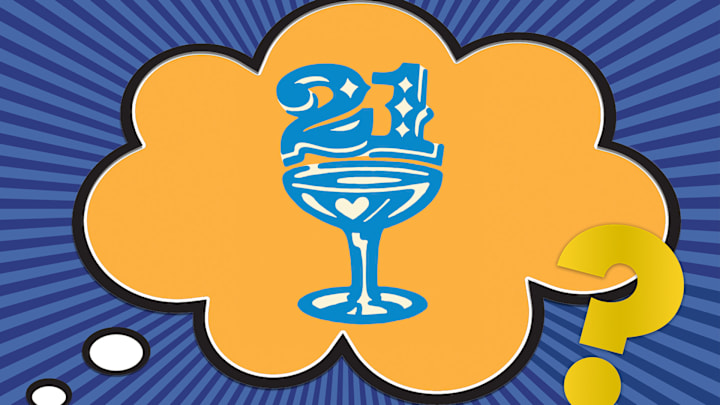Though people are legally considered adults when they hit 18, in the United States, they have to wait another three years before they can sip their first legal alcoholic beverage. Did lawmakers just pick 21 out of a hat because they wanted college seniors to learn the nuances of bar culture before graduation? Not quite.
The concept that a person becomes a full adult at age 21 dates back centuries in English common law; 21 was the age at which a person could, among other things, vote and become a knight. Since a person was an official adult at age 21, it seemed to make sense that they could drink then, too. But 21 wasn’t always the magic number needed to imbibe.
When—and why—was the drinking age 18?
Believe it or not, Franklin Roosevelt helped prompt the change in a rather circuitous fashion. FDR approved lowering the minimum age for the military draft from 21 to 18 during World War II. When the Vietnam-era draft rolled around, though, people were understandably a bit peeved that 18-year-old men were mature enough to fight, but not old enough to vote. Thus, in 1971 the states ratified the 26th Amendment, which lowered the voting age to 18. Legislators started applying the same logic to drinking. The drinking age, which the 21st Amendment made the responsibility of individual states, started dropping around the country.
Critics of the change decried rises in alcohol-related traffic fatalities among 18- to 20-year-old drivers in areas where the drinking age had been lowered. Indeed, one result of leaving states in charge of their own age was the creation of “blood borders” between states that allowed 18-year-olds to drink and those that didn’t. Teenagers from the more restrictive state would drive into the one where they could buy booze, drink, and then drive home, which created a perfect storm for traffic fatalities.
Even if teens weren’t any more predisposed than older adults to drive after they’d been drinking, all of this state-hopping meant that those who did drive drunk had to drive greater distances to get home than their older brethren, who could just slip down the block for a beer or six. More miles logged in a car meant more opportunities for a drunken accident.
When did the drinking age change back to 21?
Organizations like Mothers Against Drunk Driving began agitating for a uniform national drinking age of 21 to help eliminate these blood borders and keep alcohol out of the hands of supposedly less-mature 18-year-olds. As a result, President Reagan signed the National Minimum Drinking Age Act of 1984.
This law basically told states that they had to enact a minimum drinking age of 21 or lose up to 10 percent of their federal highway funding. Since that’s some serious coin, the states fell into line fairly quickly. Interestingly, this law doesn’t prohibit drinking per se; it merely cajoles states to outlaw purchase and public possession by people under 21. Exceptions include possession (and presumably drinking) for religious practices; while in the company of parents, spouses, or guardians who are over 21; medical uses; and during the course of legal employment.
MADD’s “Why 21?” website touts that, “More than 25,000 lives have been saved in the U.S. thanks to the 21 Minimum Legal Drinking Age.” Traffic reports show a 61 percent decrease in alcohol-related fatalities among drivers under 21 between 1982 and 1998. Raw numbers show that drunk driving fatalities have definitely dropped since the early 1980s for various age groups; according to the Foundation for Advancing Alcohol Responsibility, drunk driving fatalities overall are down 26 percent. In 2018, fewer than 1000 people under the age of 21 died from alcohol-impaired driving.
Teasing out the underlying cause of this reduction in total fatalities is no mean feat, though. Non-alcohol traffic fatalities have also declined relative to the number of miles driven over the same time period, which could be attributed to any number of causes, including increased seat belt usage, the widespread use of airbags, and other safety improvements to cars and roads. Moreover, drinking and driving for the whole population might be down as the result of increased education on its consequences, harsher penalties, improved enforcement, or increased stigmatization of drunk driving.
Who wants to lower the drinking age again?
College presidents and chancellors who supported the Amethyst Initiative—a movement launched in 2008 to reconsider the national drinking age of 21—admit that drunk driving is a serious problem, but they point out that it’s not the only potential pitfall for young drinkers. They contend that by lowering the drinking age, colleges would be able to bring booze out into the open and educate students on responsible consumption. Such education might help curb alcohol poisoning, drunken injuries, drinking-fueled violence, and alcoholism on campuses.
Interesting bit of trivia: the group takes its name from the character Amethyst in Greek mythology. She ran afoul of a drunken Dionysus, who had her turned into white stone. When the god discovered what he’d done, he poured wine on the stone, turning it into the purple rock we know as amethyst. Ancient Greeks wore the mineral as a form of protection from drunkenness.
Have you got a Big Question you'd like us to answer? If so, let us know by emailing us at bigquestions@mentalfloss.com.
A version of this story originally ran in 2018; it has been updated for 2023.
